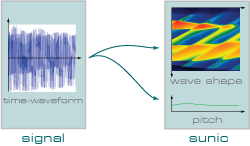Signal Modeling in the Time-Phase Domain
Signals are traditionally modelled in the time domain or in the time-frequency domain. Our modeling operates in the time-phase domain. Just like existing models this introduces an entirely new class of processing methods and algorithms applicable to signal analysis, modification and synthesis.
Signals are represented as a separation into timbre, pitch, amplitude envelope and phase offset. The timbre is visualised via a 2D coloured image referred to as cyclogram. We define :
- Pitch: the 'fundamental frequency', 'key' or 'note' as a function of time
- Cyclogram: the pitch-removed time-waveform, transformed into the time-phase domain.

This representation as a split into timbre and other components is referred to as a "sunic". The transformation between a signal and its sunic is lossless and reversible. The split allows to compare and classify audio signals based on their natural characteristics (timbre) independent of their fundamental frequency, amplitude envelope or phase offset. The splitting of a sound into its sunic requires high-accuracy pitch detection with resolutions significantly below sample duration.
Cyclograms - an Intuitive Visualisation
The cyclogram can be either visualised as a three dimensional graph or by rendering colour-coded signal values in the time-phase plane. This delivers a visual fingerprint unique to the signal, featuring graphical patterns that reveal signal characteristics, trends and events at a glance. In analogy to spectrograms, these visualisations are referred to as cyclograms.
The compact yet detailed appearance of cyclograms accelerates identification, assessment and navigation (in the case of long time series).
Image-Based Signal Processing
The visual nature of a cyclogram allows to apply standard image processing algorithms such as 'blur', 'sharpen' or 'contrast' to modify the timbre of a sound. If the results are transformed back into the time series, the results are strikingly intuitive and effective.

Existing image recognition technologies can be leveraged to implement automated assessment processes that in some situations prove to be more accurate and stable than e.g. spectral approaches.
A New Discipline in DSP
The development of new algorithms from the alternative modelling approach is in its infancy. Experiments are showing results that can not be achieved with traditional algorithms. See examples in our audio section.
